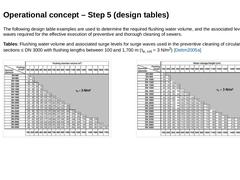
|
The following design table examples are used to determine the required flushing water volume, and the associated levels of surge waves required for the effective execution of preventive and thorough cleaning of sewers. Tables: Flushing water volume and associated surge levels for surge waves used in the preventive cleaning of circular cross sections ≤ DN 3000 with flushing lengths between 100 and 1,700 m (τe, crit = 3 N/m2) [Dettm2005a] |
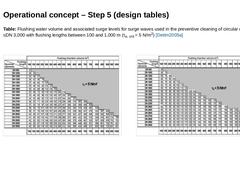
|
Table: Flushing water volume and associated surge levels for surge waves used in the preventive cleaning of circular cross sections ≤DN 3,000 with flushing lengths between 100 and 1,000 m (τe, crit = 5 N/m2) [Dettm2005a] (Image: Flushing water volume and associated surge levels for surge waves used in the preventive cleaning of circular cross sections ≤ DN 3,000 with flushing lengths between 100 and 1,000 m (τe, crit = 5 N/m2)) |
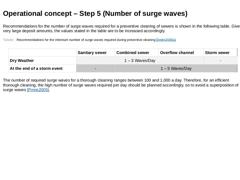
|
Recommendations for the number of surge waves required for a preventive cleaning of sewers is shown in the following table. Given very large deposit amounts, the values stated in the table are to be increased accordingly. (Table: Recommendations for the minimum number of surge waves required during preventive cleaning) The number of required surge waves for a thorough cleaning ranges between 100 and 1,000 a day. Therefore, for an efficient thorough … |
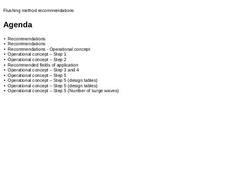
|
|
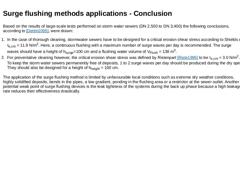
|
Based on the results of large-scale tests performed on storm water sewers (DN 2,500 to DN 3,400) the following conclusions, according to [Dettm2005], were drawn: -
In the case of thorough cleaning, stormwater sewers have to be designed for a critical erosion shear stress according to Shields of τe,crit = 11.9 N/m2. Here, a continuous flushing with a maximum number of surge waves per day is recommended. The surge waves should have a height of hsurge…
|
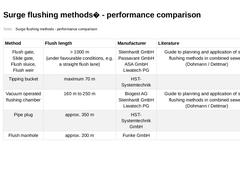
|
(Table: Surge flushing methods - performance comparison) |
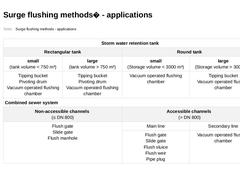
|
(Table: Surge flushing methods - applications) |
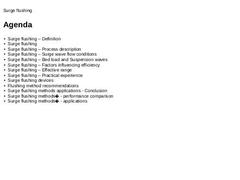
|
|

|
In the case of back-up flushing, devices are introduced into the sewer that reduce its flow cross section, back up the sewage and thus increase the flow velocity. As a result of the difference in the water level in front of and behind the devices, they are driven forward as the flushing water flows around them. In the process, the unconsolidated deposits are removed and transported [Führb1980]. |
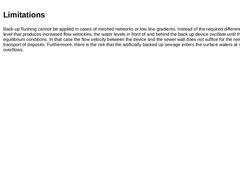
|
Back-up flushing cannot be applied in cases of meshed networks or low line gradients. Instead of the required difference in the water level that produces increased flow velocities, the water levels in front of and behind the back up device oscillate until they reach equilibrium conditions. In that case the flow velocity between the device and the sewer wall does not suffice for the removal and transport of deposits. Furthermore, there is the risk … |
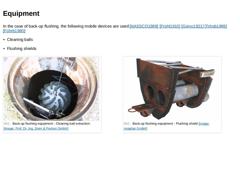
|
In the case of back-up flushing, the following mobile devices are used [NASSCO1989] [Frühl1910] [Gürsc1921] [Tchob1989] [Führb1980]: -
Cleaning balls
-
Flushing shields
(Image: Back-up flushing Cleaning balls – Process description) (Image: Back-up flushing equipment - Flushing shield) |
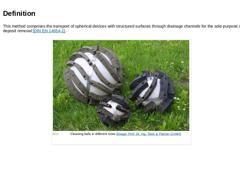
|
This method comprises the transport of spherical devices with structured surfaces through drainage channels for the sole purpose of deposit removal [DIN EN 14654-1]. (Image: Cleaning balls in different sizes) |
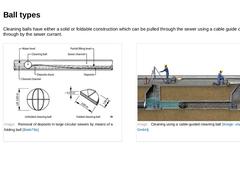
|
Cleaning balls have either a solid or foldable construction which can be pulled through the sewer using a cable guide or pushed through by the sewer currant. (Image: Removal of deposits in large circular sewers by means of a folding ball [Biele1979]) (Image: Cleaning using a cable-guided cleaning ball) |
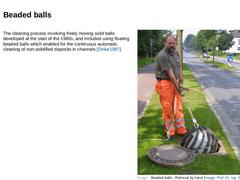
|
The cleaning process involving freely moving solid balls developed at the start of the 1980s, and included using floating beaded balls which enabled for the continuous automatic cleaning of non-solidified deposits in channels [Dinke1987]. (Image: Beaded balls - Retreval by hand) |
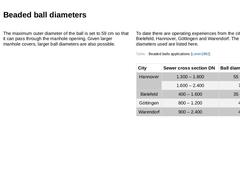
|
The maximum outer diameter of the ball is set to 59 cm so that it can pass through the manhole opening. Given larger manhole covers, larger ball diameters are also possible. To date there are operating experiences from the cities of Bielefeld, Hannover, Göttingen and Warendorf. The ball diameters used are listed here. (Table: Beaded balls applications) |

|
(Video: Depiction of principle of cleaning with beaded cleaning balls) Video: Cleaning process with the automatic insertion and extraction of beaded balls [Dinke87] [Image: visaplan GmbH]. This interactive object is only visible online. |
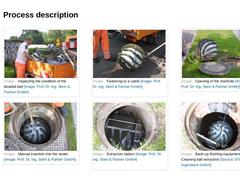
|
| (Image: Back-up flushing Cleaning balls – Process description) | (Image: Back-up flushing Cleaning balls – Process description) | (Image: Back-up flushing Cleaning balls – Process description) | | (Image: Back-up flushing Cleaning balls – Process description) | (Image: Back-up flushing Cleaning balls – Process description) | (Image: Back-up flushing Cleaning balls – Process description) |
|
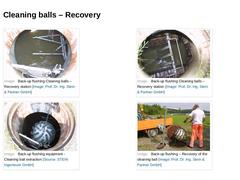
|
|
(Image: Back-up flushing Cleaning balls – Recovery station) |
(Image: Back-up flushing Cleaning balls – Recovery station) |
|
(Image: Back-up flushing Cleaning balls – Process description) |
(Image: Back-up flushing – Recovery of the cleaning ball) |
|
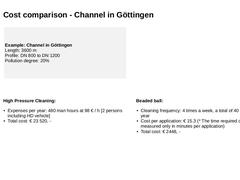
|
Example: Channel in Göttingen
Length: 3600 m
Profile: DN 800 to DN 1200
Pollution degree: 20% |
High Pressure Cleaning: - Expenses per year: 480 man hours at 98 € / h [2 persons including HD vehicle]
- Total cost: € 23 520, -
Beaded ball: - Cleaning frequency: 4 times a week, a total of 40 weeks per year
- Cost per application: € 15.3 (* The time required can be measured only in minutes per application)
- Total cost: € 2448, -
|
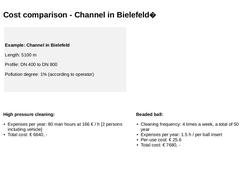
|
Example: Channel in Bielefeld Length: 5100 m Profile: DN 400 to DN 800 Pollution degree: 1% (according to operator) |
High pressure cleaning: - Expenses per year: 80 man hours at 166 € / h [2 persons including vehicle]
- Total cost: € 6640, -
Beaded ball: - Cleaning frequency: 4 times a week, a total of 50 weeks per year
- Expenses per year: 1.5 h / per ball insert
- Per-use cost: € 25.6
- Total cost: € 7680, -
|

|
|
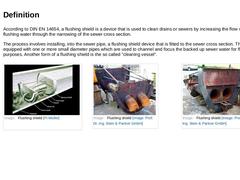
|
According to DIN EN 14654, a flushing shield is a device that is used to clean drains or sewers by increasing the flow velocity of the flushing water through the narrowing of the sewer cross section. The process involves installing, into the sewer pipe, a flushing shield device that is fitted to the sewer cross section. The shield is equipped with one or more small diameter pipes which are used to channel and focus the backed up sewer water for flushing … |
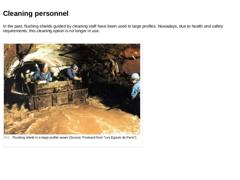
|
In the past, flushing shields guided by cleaning staff have been used in large profiles. Nowadays, due to health and safety requirements, this cleaning option is no longer in use. (Image: Flushing shield in a large profile sewer (Source: Postcard from "Les Egouts de Paris")) |
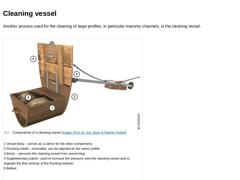
|
Another process used for the cleaning of large profiles, in particular masonry channels, is the cleaning vessel. (Image: Components of a cleaning vessel) |
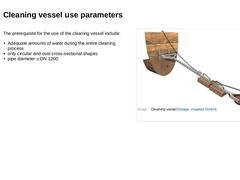
|
The prerequisite for the use of the cleaning vessel include: - Adequate amounts of water during the entire cleaning process
- only circular and oval cross-sectional shapes
- pipe diameter ≥ DN 1200
|